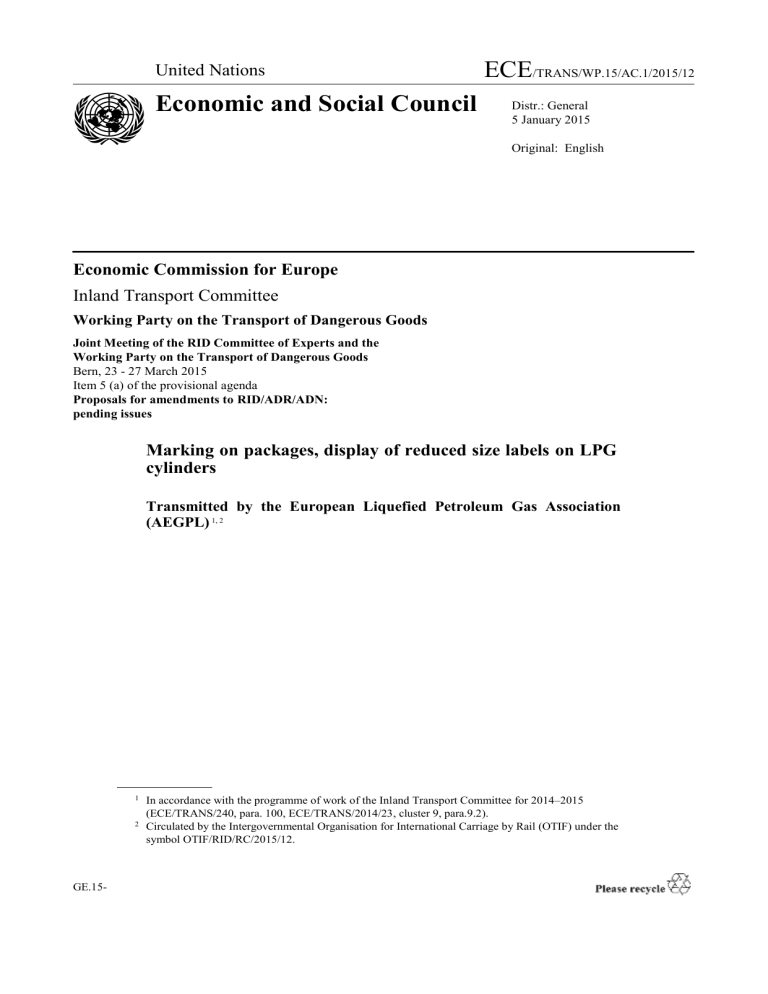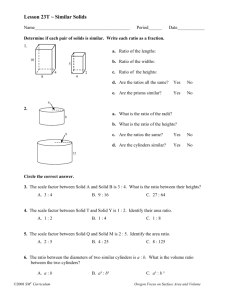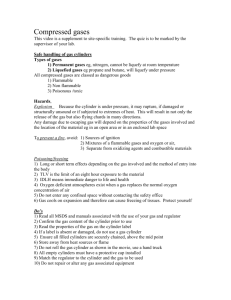1126259

United Nations
ECE
/TRANS/WP.15/AC.1/2015/12
Economic and Social Council
Distr.: General
5 January 2015
Original: English
Economic Commission for Europe
Inland Transport Committee
Working Party on the Transport of Dangerous Goods
Joint Meeting of the RID Committee of Experts and the
Working Party on the Transport of Dangerous Goods
Bern, 23 - 27 March 2015
Item 5 (a) of the provisional agenda
Proposals for amendments to RID/ADR/ADN: pending issues
Marking on packages, display of reduced size labels on LPG cylinders
Transmitted by the European Liquefied Petroleum Gas Association
(AEGPL)
1, 2
1 In accordance with the programme of work of the Inland Transport Committee for 2014–2015
(ECE/TRANS/240, para. 100, ECE/TRANS/2014/23, cluster 9, para.9.2).
2 Circulated by the Intergovernmental Organisation for International Carriage by Rail (OTIF) under the symbol OTIF/RID/RC/2015/12.
GE.15-
ECE/TRANS/WP.15/AC.1/2015/12
Background
1. According to 5.2.2.2.1.2 of ADR, “Cylinders for Class 2 may, on account of their shape, orientation and securing mechanisms for carriage, bear labels representative of those specified in this section, which have been reduced in size, according to the dimensions outlined in ISO 7225:2005, "Gas cylinders -Precautionary labels", for display on the noncylindrical part (shoulder) of such cylinders”
2. During the autumn 2012 session of the Joint Meeting, AEGPL and EIGA raised an issue concerning this current wording of 5.2.2.2.1.2 of ADR: with the introduction of new cylinder designs, (and for practical purposes), other locations for the display of the labels have been introduced. Although these alternative locations have advantages and meet the objectives of the specific precautionary labelling (the label remains visible and irremovable during transport and undamaged when the cylinder is transported or stored), there is concern that there may be an interpretation that they do not fully meet the requirements of the regulations.
3. AEGPL and EIGA were invited to work together to prepare a proposal which could be submitted to the United Nations Sub-Committee of Experts, for a new text to be included in the United Nations Model Regulations that could be subsequently introduced in
RID, ADR and ADN.
4. A document was submitted to the Sub-Committee during its summer 2014 session.
5. Although there was general support for the proposal, a main objection was opposed: if the label is placed on a non-permanent attachment that must be removed for withdrawal or use of the dangerous goods, such as a cylinder valve transport cap, then there is also a risk that the attachment and label could be placed on another cylinder package containing a different product, which could lead to misidentification of the dangerous goods.
6. In order to avoid this risk of confusion, AEGPL proposes to limit the scope of the amendment to dedicated LPG cylinders with a water capacity of 40 litres or less in including a new special provision in Chapter 3.3 of ADR.
7. Note: AEGPL is fully aware that, during its autumn 2012 session, the Joint Meeting clearly required the labels to be displayed on permanent fixtures only but it shall be underlined that:
• in some cases, to remain visible, the label must be displayed on a securely affixed attachment that is not permanent. This is the case for composite cylinders (see picture 4) that are completely covered with a casing that can be removed for maintenance or inspection;
• in some cases a label is placed on the cylinder cap and this offers higher visibility
(from the road) while the cylinder is on the truck during transport, compared to being on the shoulder of the cylinder (see picture 1 & 2);
• such a cylinder is not possible to be loaded/transported without its cap since the cap is the only handling device of the cylinder;
• in such case, cylinder cap labelling constitutes in addition an operations optimisation practice (incl. cost optimisation) as the cylinders are repainted and refreshed without need of re-stamping the label on the body.
2
.
Related documents:
ECE/TRANS/WP.15/AC.1/2015/12
Informal document INF.16 submitted at the autumn 2012 session of the Joint Meeting.
ST/SG/AC.10/C.3/2014/35 submitted at the summer 2014 session of the Sub-Committee of experts on the Transport of
Dangerous Goods.
ST/SG/AC.10/C.3/2014/83 submitted at the winter 2014 session of the Sub-Committee of experts on the Transport of
Dangerous Goods.
Introduction
8. Within 5.2.2.2, (Provisions for labels), 5.2.2.2.1.2 allows for cylinders of Class 2 to display labels which have been reduced in size according to ISO 7225:2005 on the noncylindrical part (shoulder) of such cylinders. This ensures that labels are visible during transport. This provision accommodates the majority of cylinders in service.
9. However, according to specific LPG industry practices and in the case of new cylinders designs, other locations for the display of the labels may be used (see attached pictures 1 to 5 in Annex 1). Although these alternative locations have advantages and meet the objectives of the specific precautionary labelling (the label remains visible and irremovable during transport and undamaged when the cylinder is transported or stored), they do not meet fully the wording of 5.2.2.2.1.2.
10. The proposal is to permit the display of the label on a fitting securely attached (for transport) to the upper part of the cylinder or valve (casing, handling device).
Proposal
11. In order to take into account new cylinder designs and existing practices in the LPG industry and to provide clarification to the regulations it is proposed to add a new special provision in 3.3.1 of ADR:
“6XY: For cylinders with a water capacity of 40 litres or less, labels reduced in size according to ISO 7225 may be displayed on a securely affixed attachment (for transport) to the upper part of the cylinder (e.g. collar, handling device)”.
12. Insert ‘6XY’ in column (6) of the Dangerous Goods list for the entries for UN numbers 1011, 1075, 1965, 1969 and 1978.
Justification
13. The justification is that it clarifies where labels may be affixed such that the appropriate information is readily available.
Safety implications
14. No safety implications are foreseen as this will ensure that labels are securely attached to cylinders and visible. Moreover, this new wording would permit the labels to be displayed beside the UN number and letters “UN” corresponding to the dangerous goods onto the handling device (see 5.2.1.1.).
15. By limiting the scope of the amendment to dedicated LPG cylinders with a water capacity of 40 litres or less, there is no risk of confusion with other gases cylinders and other related hazards. This type of cylinder is very specific:
3
ECE/TRANS/WP.15/AC.1/2015/12
• by design, dimensions and construction,
• by operations (filling, logistics),
• and their customers’ segment as well (mainly domestic).
The risk of fitting the attachment of an LPG cylinder to another gas cylinder is very low and, in any case, the individuals that accept the cylinders for transport or carry the cylinders for transport have to be trained according to the regulation and would therefore reject a cylinder that is not fitted with its adequate fitting. It should be noticed that the cap is used as a handling and protection device.
16. Concerning the end user information once the cap is removed from the cylinder for, use, it is regulated, in the European Union, by Regulation (EC) No 1272/2008 of 16
December 2008 on classification, labelling and packaging of substances and mixtures
(Regulation CLP). In compliance with the CLP requirements, cylinders shall bear Hazard labels, as well as precautionary statements and other information, once the cap is removed and while the cylinder is being used. A way of fulfilling this requirement is illustrated by the picture attached in Annex 2.
4
Annex 1
Examples of cylinder labelling for LPG Cylinders
ECE/TRANS/WP.15/AC.1/2015/12
1
Label on cap
2
3
Label on fixed guard
4
Label displayed on the casing
5
ECE/TRANS/WP.15/AC.1/2015/12
5
Label located beneath valve
6
Annex 2
ECE/TRANS/WP.15/AC.1/2015/12
Classification, labelling and Packaging Regulation (CLP)
Note: in the above picture, the Hazard label is provided “on a durable information disc or label held captive on the cylinder." as allowed by Regulation (EC) No 1272/2008 of 16
December 2008 on classification, labelling and packaging of substances and mixtures
(Regulation CLP - Annex I- 1.3.1 b).
7






